Ulungur River
| Ulungur River | |||
|---|---|---|---|
| Simplified Chinese | 乌伦古河 | ||
| |||

The Ulungur River / Urungu River or Urungu (Mongolian: Өрөнгө гол, romanized: Öröngö Gol, Chinese: 乌伦古河; pinyin: Wūlúngǔ hé), in its upper reaches in Mongolia known as the Bulgan River (Mongolian: Булган гол), is a river of China and Mongolia. It rises in the Altai Mountains in western Mongolia, flows south into China's Xinjiang (Altay Prefecture), where it turns north-west to empty into the Ulungur Lake. It is about 700 km long.
The Irtysh–Karamay Canal crosses the Ulungur River at 46°36′15″N 87°56′52″E / 46.60417°N 87.94778°E, on an aqueduct.
Geological history
[edit]In the early Quaternary, the Ulungur (as well as the upper Irtysh) flowed into the Dzungarian Basin, terminating in a large lake (the "Old Manas Lake") in the region of today's Lake Manas. Later tectonic movements redirected the Ulungur onto its current course.[1]
Wildlife
[edit]The Sino-Mongolian beaver, Castor fiber birulai, is found only in the basin of the Ulungur River. The population is considered endangered. The Bulgan Beaver Nature Reserve (Chinese: 布尔根河河狸自然保护区; 46°12′00″N 90°45′00″E / 46.20000°N 90.75000°E) has been established on the Bulgan River (a tributary of the Ulungur River) in Qinggil (Qinghe) County in 1980 to protect the creatures.[2][3]
References
[edit]- ^ Yao, Yonghui; Li, Huiguo (2010), "Tectonic geomorphological characteristics for evolution of the Manas Lake", Journal of Arid Land, 2 (3): 167–173, doi:10.3724/SP.J.1227.2010.00167
- ^ Hongjun Chua and Zhigang Jianga, Distribution and conservation of the Sino-Mongolian beaver Castor fiber birulai in China. Oryx / Volume 43 / Issue 02 / April 2009, pp 197-202
- ^ Riley, Alex (28 July 2016). "Extinct giant beavers made corkscrews instead of dams". BBC Earth. Retrieved 29 July 2016.
46°59′58″N 87°26′25″E / 46.99944°N 87.44028°E
Links
[edit]
Text is available under the CC BY-SA 4.0 license; additional terms may apply.
Images, videos and audio are available under their respective licenses.
